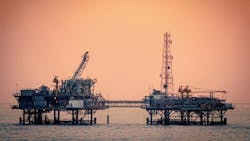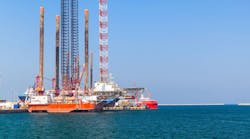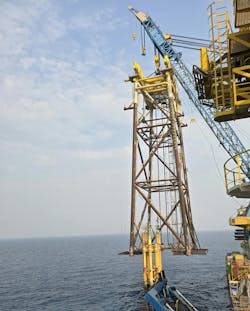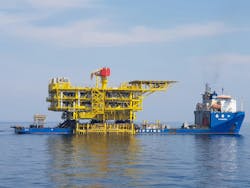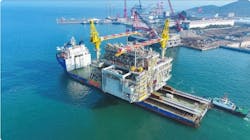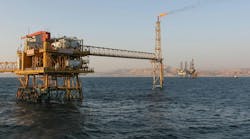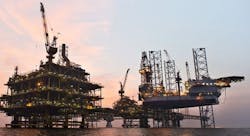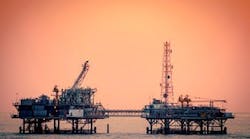Middle East operators employing a range of brownfield strategies to boost production
Key Highlights
- Major offshore fields in the Middle East, including Safaniya, Marjan, Zuluf, and Upper Zakum, are undergoing extensive brownfield upgrades to extend their operational life and increase production capacity.
- Investments in regional offshore projects are projected to reach $260 billion from 2025 to 2030, with a focus on infrastructure upgrades, subsea tiebacks, and enhanced oil recovery (EOR) techniques.
- The Gulf Cooperation Council (GCC) forecasts offshore production rising 30% to 14.9 million barrels of oil equivalent per day (MMboe/d) by 2028, largely via brownfield expansions.
By Bruce Beaubouef, Managing Editor
Brownfield strategies have become increasingly relevant in the Middle East, where many of the larger offshore oil fields have been in production for decades. In the Persian Gulf (Arabian Gulf), Arabian Sea, Red Sea, and eastern Mediterranean, operators have been employing a mix of enhanced oil recovery (EOR) techniques, infrastructure upgrades, and tiebacks to existing platforms to extend asset life, boost recovery rates, and improve operational efficiency.
Operators including Saudi Aramco, ADNOC, and QatarEnergy have been investing heavily in the region, which is projected to account for nearly half of global offshore supply growth by 2030.
The Gulf Cooperation Council (GCC) forecasts offshore production rising 30% to 14.9 million barrels of oil equivalent per day (MMboe/d) by 2028, largely via brownfield expansions. Total investments in Middle East offshore projects are expected to hit $260 billion from 2025–2030, with brownfields comprising a significant share.
The Persian Gulf (the Arabian Gulf) is the epicenter of brownfield activity, with mature fields like Safaniya (Saudi Arabia), Marjan (Saudi Arabia), Zuluf (Saudi Arabia), Upper Zakum (UAE), and the Idd El-Shargi North Dome (ISND) field (Qatar) undergoing major revamps. Strategies vary across the region, but often involve platform life extensions, subsea tiebacks, and EOR techniques to counteract natural decline rates.
For Saudi Arabia, the Marjan, Zuluf, and Safaniya fields are considered to be among the largest offshore oil fields in the Kingdom. Expansion projects in these three fields – driven by brownfield strategies – are thus considered to be key components of Saudi Aramco’s long-term strategy to maintain and increase its oil production capacity.
Below are some of the highlights from some of these Persian Gulf/Arabian Gulf brownfield expansion projects.
Safaniya field expansion
Much of the work in this region involves retrofitting aging platforms with new modules and building new pipelines to tie into satellite fields. Most notable in this region is Saudi Aramco’s Safaniya brownfield project, which seeks to increase production from this field to 1.5 MMbpd by 2027 through a series of brownfield upgrades.
Located off Saudi Arabia’s eastern coast, the Safaniya oil field is the world’s largest conventional offshore oil field by recoverable reserves, estimated at over 37 billion barrels of oil and 5.6 trillion cubic feet of associated gas. Operated by Saudi Aramco, it spans approximately 65 km by 15 km, lying 200 km north of Dhahran in shallow waters (30–50 meters). Discovered in 1951 and operational since 1957, Safaniya is a cornerstone of Saudi Arabia’s oil production. Its current output is ~1.2–1.3 MMbpd, with plans to sustain or increase to 1.5 MMbpd by 2027 through brownfield upgrades. It accounts for ~15% of Saudi Aramco’s total oil output.
Safaniya’s mature status, with over 65 years of production, necessitates brownfield strategies to counter natural decline rates (5–10% annually) and extend field life. Saudi Aramco’s $10+ billion investment in the Safaniya Master Development Plan (SMDP) and related projects – such as CRPO 104–113 and CRPO 88 (CRPO being an acronym for contract, release and purchase order) – are focusing on infrastructure upgrades, EOR methods, and digitalization techniques. Some of the key initiatives of the SMDP are outlined below.
- CRPO 104–113 & CRPO 88. This involves the installation of 10 new platforms and upgrades to existing ones, with the goal of adding 300,000 bpd capacity by 2025. These include drilling platforms, tie-in platforms, and subsea pipelines (200 km) to connect satellite reservoirs.
- New wellhead platforms. There have been more than 100 new wellhead platforms installed since 2020, with 20 to 30 added in 2024–2025, equipped with automated drilling and smart completion systems.
- Subsea systems expansion. This involves expanded subsea tiebacks to integrate smaller reservoirs into the main system, reducing development costs by 20–25% compared to greenfield projects.
These steps are expected to extend field life by 15 to 20 years, thereby bolstering the goal of sustained 1.5 MMbpd output.
In terms of EOR, the SMDP calls for the following:
- Water injection. Safaniya relies heavily on peripheral water injection (seawater and treated produced water) to maintain reservoir pressure, recovering 10–15% additional oil. Recent upgrades include high-pressure pumps and smart injection monitoring.
- Chemical injection trials. Pilot projects in 2024 tested polymer flooding to improve sweep efficiency in viscous oil zones; the goal here is to boost recovery by 5 to 10%.
- Gas injection. To date there has been limited gas reinjection due to associated gas constraints, but plans for 2026 include CO₂ injection pilots to align with net-zero goals.
These EOR actions are expected to increase recovery from ~40% to ~50–55% in targeted zones.
In terms of digitalization and smart technologies, Saudi Aramco is deploying a range of “4IR Technologies,” including AI-driven model predictive control and IoT sensors for real-time reservoir monitoring, reducing downtime by 15% and energy use by 20%. It has also deployed a field-wide digital twin, implemented in 2024. This system optimizes drilling and predicts maintenance needs, cutting operational costs by $100 million annually. Aramco also has the goal of equipping over 200 wells with “smart” or intelligent completions technologies by 2025, allowing remote flow control and data analytics.
The brownfield strategy hit a stumbling block in February 2025, when Saudi Aramco canceled the bidding process for a significant expansion of the Safaniyah field. The decision to cancel the expansion bidding, worth over $10 billion, was in line with the government’s order to halt plans for exceeding its new maximum sustainable capacity of 12 million barrels a day. Reports indicate that existing production is not being shut down, but the large-scale expansion that had been planned is now deferred. Other expansion projects that had already reached the final investment decision stage are expected to continue as planned.
Marjan Increment Program
Saudi Aramco’s Marjan Increment Program (MIP) is a flagship brownfield development project aimed at revitalizing the mature Marjan offshore oil and gas field in the Arabian Gulf (Persian Gulf), located about 85 km northeast of Tanajib and 260 km northeast of Dhahran, Saudi Arabia.
Discovered in 1967 as part of a wave of offshore finds that expanded Aramco's portfolio, Marjan has been producing for decades but faces natural decline. The program, announced in 2017, represents an integrated approach to boosting capacity across oil, associated gas, non-associated gas, and cap gas, while incorporating sustainability measures. With a total investment of approximately $12–18 billion, it is one of Aramco’s most complex offshore undertakings, involving unprecedented construction in a congested field with over 100 existing platforms.
As of October 2025, the project is in the advanced construction and commissioning phases, with full onstream expected by late 2025, adding 300,000 bpd of Arabian Medium crude oil, raising field capacity from 500,000 bpd to 800,000 bpd; and 2.5 billion standard cubic feet per day (Bscfd) of gas processing, plus 360,000 bpd of natural gas liquids.
The program is targeting a comprehensive increase in Marjan’s output, countering decline rates of 5–8% annually in mature reservoirs. It integrates upstream development (new wells and injection systems) with midstream processing to handle increased volumes of oil, gas, and condensates.
Unlike traditional projects, the MIP is “holistic” – combining offshore and onshore facilities in one program, including oil/gas/water injection platforms, subsea infrastructure, and processing plants. This “one-stop” approach is designed to minimize interfaces and costs.
The MIP also emphasizes carbon intensity reduction through advanced well completions, reservoir management, and technologies like AI-driven inspections. It aligns with Aramco’s net-zero by 2050 ambitions by optimizing energy use and flaring.
The program is divided into multiple packages (e.g., Packages 1–12), blending brownfield upgrades (tiebacks to existing platforms) with newbuilds. For example, the MIP calls for 24 new offshore platforms for oil production, water injection, and gas injection, plus upgrades to existing ones. This includes six heavy platforms (4,500–6,700 tons each, up to 90m x 52m footprint) installed via floatover methods. It also includes three new tie-in platforms (TP11–TP13) for subsea connections. It also calls for smart completions technologies to be deployed on 200-plus new wells, with remote monitoring capabilities.
In terms of subsea Infrastructure, the MIP calls for 200-plus km of pipelines and 250 km of cables to link reservoirs and facilities. This includes complex networks for oil export, gas gathering, and injection systems. It also includes the longest subsea cables ever laid by Aramco for power and data transmission.
As part of the MIP, Saudi Aramco has developed the “slipover solution,” a method for upgrading existing platform facilities. As detailed by Muath S. Alturaif and Rameshkumar Kutti Ekanathan of Saudi Aramco in the September-October 2025 issue of Offshore, this method has been shown to extend the life of aging offshore wellhead facilities, and enhance their production efficiency. The technique involves the deployment of a slipover jacket structure and modular topsides on top of existing wellhead equipment. In so doing, the “revived” platforms can then allow higher capacity vessels and helicopters to approach the platform, and thereby extend operational lifespans while leveraging the existing conductor systems, wells and x-mas tree assets.
Zuluf field expansion
The Zuluf field is a large, conventional offshore oil field located in the Arabian Gulf. The field is situated in shallow waters, approximately 40 km offshore the northeast coast of Saudi Arabia, and is estimated to have over 31 billion barrels of oil-equivalent in proven reserves. Owned and operated by Saudi Aramco, production from the field began in 1973.
It is a major asset for Saudi Arabia, and for the past few years has been undergoing a large-scale expansion project to increase its production. Aramco has been working towards this end by adding new platforms, subsea infrastructure, and pipelines.
A multi-billion-dollar expansion project was initiated in 2018 to increase Zuluf’s production capacity by over 600,000 bpd, nearly doubling the field’s output to 1.4 million bpd of heavy crude oil. A key component of this expansion is the development of a fourth offshore gas oil separation plant (GOSP-4).
GOSP-4 has been designed as a central offshore processing facility to handle planned incremental output, incorporating modern electrification for electrical submersible pumps, gas compression, and power recovery systems (replacing aged gas turbines with rental diesel-powered generators for efficiency). The construction of GOSP-4 is ongoing, but the plant is expected to be placed online next year. This timeline was recently reaffirmed despite Aramco scaling back some broader expansion plans, as Zuluf (along with the Marjan and Berri fields) has been prioritized for completion.
It should be noted that Zuluf GOSP-4 facility is separate and distinct from the GOSP-4 complex related to the MIP, which will be a multi-platform facility for 475,000 bpd oil and 750 million cubic feet per day of gas. These are distinct projects under Saudi Aramco's Northern Area Producing Region (NAPR) expansions for the Zuluf, Marjan, and Safaniya fields, with no overlap in GOSP-4 references.
Saudi Aramco has awarded multiple engineering, procurement, construction, and installation (EPCI) contracts to advance the expansion. In recent years, major contracts have been secured by companies including McDermott International, L&T Hydrocarbon Engineering, Subsea 7, and the National Petroleum Construction Company (NPCC). As of mid-2025, Saudi Aramco had awarded contracts for a new phase of the expansion, with an estimated value of around $5 billion, to boost production capacity further.
Additionally, the Zuluf expansion involves the installation of new platforms, subsea pipelines, and cables while decommissioning older infrastructure. Aging infrastructure is being phased out in favor of these new electrified platforms to extend the field's life and increase efficiency.
Upper Zakum field expansion
The Upper Zakum offshore oil field, located approximately 84 km northwest of Abu Dhabi in the United Arab Emirates, is one of the world’s largest hydrocarbon reserves. Discovered in 1963, it holds estimated proven crude oil reserves of around 50 billion barrels, making it the second-largest offshore oil field and the fourth-largest oil field globally. Production began in 1982, and it is currently the largest producing field in ADNOC’s portfolio, contributing significantly to the UAE’s oil output. The field is operated by ADNOC Offshore, a subsidiary of the Abu Dhabi National Oil Company (ADNOC).
ADNOC has been employing EOR methods as part of its ongoing expansion and development projects, such as the UZ 750 project. EOR methods were deemed essential to increasing the field’s production capacity and included a combination of strategies like artificial lift, gas lift, and other techniques to boost recovery. These efforts involved creating artificial islands that could accommodate multiple wells and processing facilities. Later phases include installing an integrated gas lift compressor, a gas dehydration unit, and a vapor recovery system, which are all crucial components for EOR.
ADNOC’s ongoing brownfield strategy for Upper Zakum expansion is designed to optimize existing infrastructure to support ambitious production targets (1.2–1.5 million bpd) while integrating EOR to maximize recovery from its mature reservoirs. EOR, particularly gas injection, is central to this strategy, enabling higher yields from existing wells. By combining infrastructure upgrades, AI-driven operations, and sustainable practices, ADNOC is looking to ensure that the Upper Zakum field remains a cornerstone of UAE’s oil production program.
This past June, it was reported by regional news services that ADNOC was preparing to start the tendering process for the next expansion phase of the Upper Zakum field development, the objective of which is to increase the asset’s oil production potential to 1.5 million barrels per day.
The ISND5-2 project
QatarEnergy is advancing the ISND5-2 project, a major brownfield offshore oil and gas development initiative focused on the expansion of the Idd El-Shargi North Dome (ISND) field.
ISND is one of Qatar’s largest offshore oilfields, located approximately 85 km east of Doha in the Persian Gulf. Discovered in 1960, the field consists of the larger North Dome and smaller South Dome structures and has been a key producer of crude oil, with historical production targets around 100,000 barrels of oil per day.
The project falls under Phase 5, Batch 2 (ISND5-2) of the field’s expansion, aimed at sustaining and enhancing production at the ISND field. The project calls for drilling over 200 new wells (production, water injection, and water source) and installing supporting facilities like wellhead platforms, pipelines, and processing equipment.
The supporting facilities include three new wellhead platforms, nine subsea pipelines, five umbilical cables, and four subsea skids, all of which must integrate seamlessly with the field’s existing wellhead jackets, processing facilities, and subsea systems. This requires precise engineering to avoid disruptions to ongoing production.
China Offshore Oil Engineering Co., Ltd. (COOEC) won the contract for the project in January 2024, with formal signing following in June 2024. The contract was valued at approximately 2.216 billion Qatari riyals, equal to about US $609 million or about 4.437 billion Chinese yuan. The project has an expected duration of 43 months, with completion targeted for early 2028.
Editorial webinar coming soon:
About the Author
Bruce Beaubouef
Managing Editor
Bruce Beaubouef is Managing Editor for Offshore magazine. In that capacity, he plans and oversees content for the magazine; writes features on technologies and trends for the magazine; writes news updates for the website; creates and moderates topical webinars; and creates videos that focus on offshore oil and gas and renewable energies. Beaubouef has been in the oil and gas trade media for 25 years, starting out as Editor of Hart’s Pipeline Digest in 1998. From there, he went on to serve as Associate Editor for Pipe Line and Gas Industry for Gulf Publishing for four years before rejoining Hart Publications as Editor of PipeLine and Gas Technology in 2003. He joined Offshore magazine as Managing Editor in 2010, at that time owned by PennWell Corp. Beaubouef earned his Ph.D. at the University of Houston in 1997, and his dissertation was published in book form by Texas A&M University Press in September 2007 as The Strategic Petroleum Reserve: U.S. Energy Security and Oil Politics, 1975-2005.
